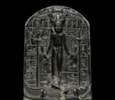Omar Pacha Cippus of Horus-Shed
Omar Pacha Cippus of Horus-Shed
Circa 332-330 B.C., Ptolemaic Period, Egypt
Steatite
H: 12.5
Sold
A black steatite magical stele depicting the nude child-god Horus-Shed (‘Horus the Saviour’) standing with his feet balanced on two crocodiles. In each hand he holds two long serpents and one scorpion by their tails. He also holds a long-horned oryx in his proper right hand and a lion in his left, hanging down on either side of his legs. He sports the sidelock of youth, draped over his right shoulder. Above Horus-Shed’s head, the head of the dwarf god Bes is carved in high relief. A series of other deities in human and animal form are incised in the horizontal and vertical registers framing the central gods. Horus-Shed is flanked by standards in the form of lotus and papyrus columns (the symbols of North and South Egypt). Both sides of the stele are inscribed, with twelve registers of text filling the sheer side of the reverse. These inscriptions evoke the cure by Re of the infant Horus from snake and scorpion bites, after he had been hidden in the papyrus swamps by his mother Isis. A lunette featuring a multi-headed solar deity kneeling within a sun disc enclosed by large ka-arms is carved in the centre of the verso side, above the inscriptions. A line of four baboons, with their arms raised in sun worship, stand on either side of the lunette. The sides and bottom of the base of the cippus are also inscribed with other apotropaic lines.
The is one of about 400 known magical stelae featuring Horus-Shed. They are generally inscribed with healing spells referring the above story, which may have been intended to cure the wielder from a snake bite or scorpion sting. Other spells found on cippi usually allude to broader themes of healing, rejuvenation, and renewal. It is thought that these spells could be activated by pouring water over the cippus to transform it into a curative remedy to be imbibed or applied to the skin. It has also been theorised that rubbing or kissing the stone could activate the spells, as suggested by particular patterns of ancient wear, as seen on the face of Horus-Shed in this example.
TEFAF Maastricht, Netherlands, 12-21 March 2010.
On loan to the Staatliches Museum Ägyptischer Kunst, Munich, November 2013-March 2021.
Frieze Masters, London, October 2024
Collection de Feu Omar Pacha Sultan Le Caire (Paris, 1929), no. 274, pl. XLIV.
Maarten van Laarhoven, ‘Handelaar die left bij gratie van de pracht’, Limburger, 15 March 2010.
Private Collection of Omar Pacha Sultan, Cairo, by at least 1929.
With Galerie du Sycomore, Paris, by at least 1979.
French private collection, Paris, acquired from the above in 1979.
With Sycomore Ancient Art, Geneva, 2010, accompanied by a sales invoice dated 15 March 2010.
Private Collection of Sheikh Saoud Al Thani, Doha, Qatar, from at least 2013.
Private Collection of Ms. Natsagsuren Mangalam, Mongolian noble family Tengernuden
ALR: S00248666, with IADAA Certificate, this item has been checked against the Interpol database.
Omar Pacha Sultan was the first Egyptian to build a collection of ancient Egyptian artworks, gathering over one thousand pieces, which he kept in his Selamlik in Cairo in what was effectively a private museum. Pacha made frequent trips to Upper Egypt and visited Cairo merchants daily. He focused his attention, not on pieces of significant archaeological import, which invariably made their way into museums, but on those smaller works that appealed to him as an enthusiastic antiquarian. His goal was to own the rarest small antiquities. During the period in which Pacha was collecting, he endeavoured to acquire as complete a collection as possible, no matter the cost. Highlights of his collection include comprehensive groups of bronze divinities, scarabs, and funerary statuettes of wood, enamelled ceramics, and stone. It also featured gold coins and jewellery, and iridescent glassware. Pacha also collected Islamic works, such as vases, carpets, woodwork and furniture; a handwritten Qur’an that previously belonged to Caliph Osman featured in his collection.










 Enquire
Enquire




